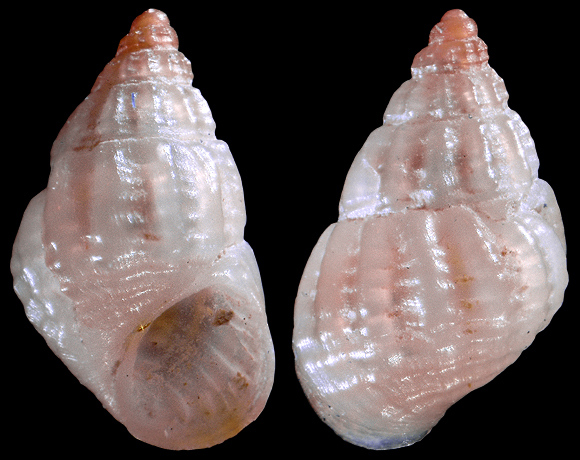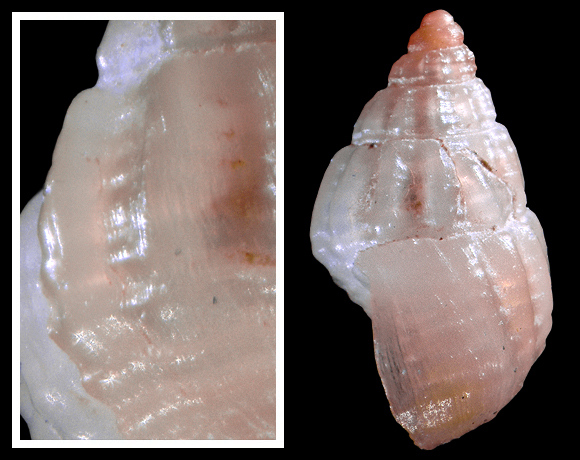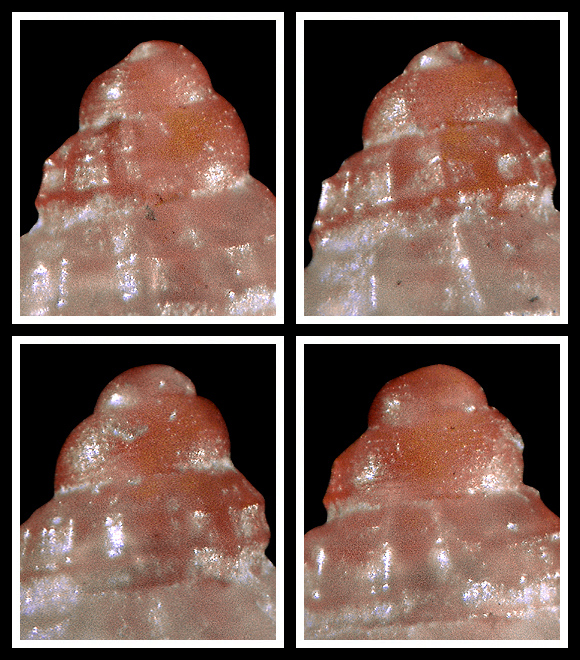
The shell of this species is rather variable in colour but remains constant in its morphology: « Alvania elisae has a solid shell, oval-conical, with moderately convex whorls, a well marked sculpture; colouration variable from a waxen white to mahogany, with often the protoconch darker, slaty-reddish. Adult specimens are about 3,5-4mm in height. […] The spiral beads, which are 5 on the last whorl, of the same colour than the test, are well marked and tend to merge with the axial costae, sometimes almost disappearing in the overlap, sometimes forming marked rounded nodules. On the last whorl, the axial costae, well formed, are 15-16 in number. On the base there are 3 conspicuous cords, wider than their interspaces; the continuation of the axial ribs is perceptible, as well as the rounded protuberances that appear at the intersection with the spirals. » – A. Margelli: “ A new species from Capraia Is. (Tuscan Archipelago): Alvania elisae sp. nov.”, La Conchiglia vol. 300, p.44-45.
Above and below: a pale specimen collected at 45m deep, near the Grotta Azzurra, Capri, Campania, SW. Italy. 3,5mm.

« The lip, thickened but with a sharp edge even in adults, bears an internal denticulation (only in mature specimens) made up of 8 raised labial folds corresponding, by the position, but with a clearly smaller size, to the external spiral ribs, those of the whorl as welll as the basal ones. » – Ibid. The shell, especially in pale specimens, looks very close (deep suture, whorls almost flat, no spiral microsculpture) to that of Alvania settepassii from the same region, but it differs by the higher number of radials (« 15-16 contro 7-9 »); by the presence, often, of marked protuberances at the intersections radials / spirals; and by the more sculptured base.

Protoconch. Microsculpture made up of 11-12 flattened spiral cords. The transition with the teleoconch is primarily morphological, the microsculpture disappearing abruptly in the first radial. The apical colour, for its part, changes one whorl later by progressively fading into the general colour of the shell. Derivatio nominis: named after the author’s daughter.
Anatomically, elisae, at first sight, is quite similar to settepassii, with a translucent foot bordered with very luminous lemon-yellow margins, and tentacles of the same vivid colour; the foot of settepassii is also translucent, the yellow bands and tentacles being, though, more sulfur-yellow than lemon. In fact, both species may share the same ancestor.
Anatomically, elisae, at first sight, is quite similar to settepassii, with a translucent foot bordered with very luminous lemon-yellow margins, and tentacles of the same vivid colour; the foot of settepassii is also translucent, the yellow bands and tentacles being, though, more sulfur-yellow than lemon. In fact, both species may share the same ancestor.